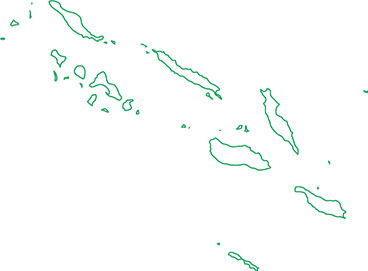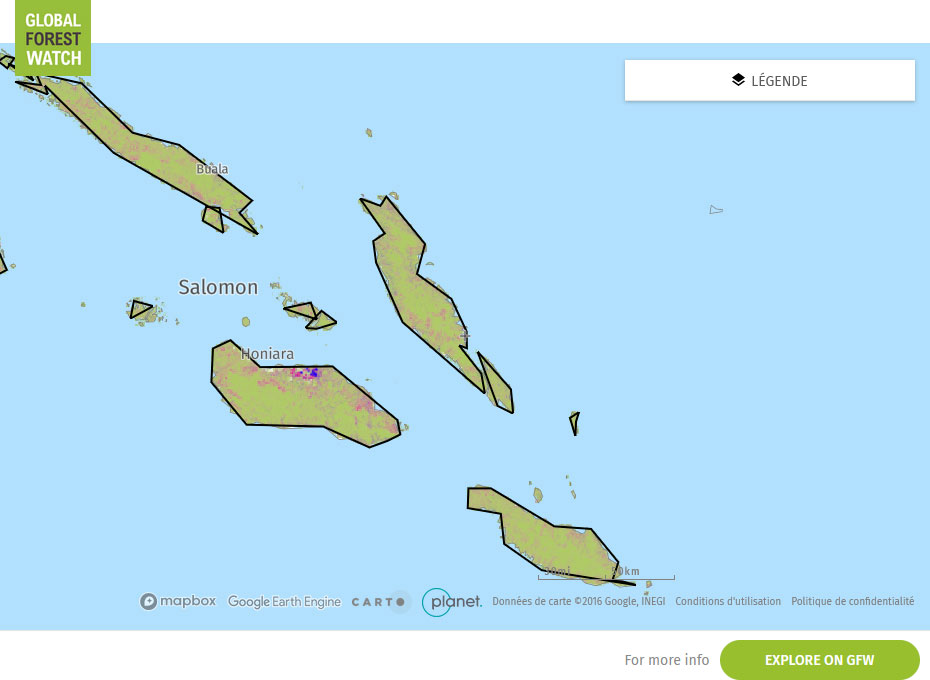Forest resources and context of Solomon Islands
Solomon Islands has a forest cover of nearly 90% of its total land area. Its forests are within the tropical forest zone and consist of lowland forest, hill forest, montane forest, freshwater and saline swamps, and riverine and mangrove forests.

Land surface
2.8million ha
Forest cover
2.5million ha
Production forest
0.8million ha
Forest ownership
16% publicly
Forest resources in Solomon Islands
Types of forest
The country falls within the worlds moist tropical rain forest zone. Over rugged terrain on the six main islands forests stretch from sea level to an altitude of over 1,000 meters. Natural forest is classified into five main forest types (see table).
- Lowland Forest
Forest on level or nearly level land below 200 meters above sea level.
Area: 51%
Main tree species:
Campnosperma brevipetiiolata, Dillenia salmonensis, Endospermum medulllosum, Parinari salomonensis. - Hill Forest
Forest between 200 meters up to 600 meters above sea level on well- drained soils.
Area: 38%
Main tree species:
Pometia pinnata, Gmelina moluccana, Elaeocarpus sphaericus, Campnosperma brevipetiolata. - Montane Forest
Forests at higher altitude ridge tops generally greater than 600 meters above sea level.
Area: 10%
Main tree species:
Callophyllum pseudovitiense, Eugenia spp., Dacrydium spp., Pandanus spp., Racembambos scandens. - Freshwater Swamp and Riverine Forests
Forest on land with little relief and impeded drainage.
Area: 1%
Main tree species:
Inocarpus fagifer, Mextroxyon salomonense, M. sagu, Barringtonia racemose. - Mangroves and Saline Swamp Forest
Forests on land subjected to tidal influences such as estuaries and foreshores.
Area: 0.3%
Main tree species:
Barringtonia asiatica, Calophyllum inophyllum, Casuarina equisetifolia, Teminalia catappa.
The Solomon Islands is located in the pacific, spreads over 9,900 islands, and covers about 28,000 km2 of land area. The population is estimated at 515,870 (25 people per km2) with an annual growth rate of 2.3%. About 80% of the population lives in rural areas, and only 20% in cities (Census; 2009). The archipelago is mainly mountainous with some extensive plains, and the country has one of the highest percentages of forest cover in the pacific region. The total forest cover is estimated around 89.9% of the total gross land area (FAO, 2018). The vast majority (99%) of the forest area in the Solomon Islands is natural forest, followed by small areas of commercial plantations (0,95%) and community woodlots (0,05%) (Solomon Islands Government, 2018).
The Solomon Islands’ vegetation is diverse, and the country is listed under the Global 200 Ecoregions (MECDM, 2016-2020). Its montane forests represent a globally important bird area which led to Solomon Islands being categorized as an “Endemic Bird Area” (EBA) (Kool et al. 2010). The country has no national protected areas network, meaning existing ecosystem protection is provided only through provincial ordinances and customary law. Terrestrial areas under these forms of protection account for an estimated 5% of land area (Solomon Islands Government, 2014).
Between 2001 and 2017, the total forest area of the Solomon Islands was reduced by 9,840 ha, which represents a total deforestation rate of 0.39%, or a mean annual deforestation rate of 0.02%. The main driver of deforestation conversion of forest to subsistence agriculture. This occurs predominantly (65%) in lowland forest and, to a lesser extent, in hill forest (FAO, 2018).
The recommended sustainable timber harvest rate is estimated at 250,000 m3 per year, but since 2006 the volume of logs exported has gradually exceeded 1,000,000 m3. This export volume increased in recent years and reached a peak in 2018 of 2,700,000 m3. Nearly 85 % of the active felling licenses are currently operating in already logged over forest (MOFT, 2018).
Solomon Islands is divided into nine administrative areas or provinces, which are administered locally by elected provincial assembly members and headed by provincial premiers. Yet, the power to manage and control the forest resources is vested in the national government through processes and procedures. The current Forestry Act does not give power or rights to provincial governments to manage or harvest forests.
Forest ownership in Solomon Islands
Most forest land (87%) in the Solomon Islands is under customary ownership, and only around 13% is under corporate or private ownership (Pauku, 2009). Ownership includes the rights to almost all above-ground natural resources, including forests. Landowner groups are legally entitled to be involved in management decisions concerning their forest. Customary ownership is often a major constraint to proper forest management, because free access and exploitation of the forest resources often lead to unsustainable forest harvesting practices.
key figures
| Land surface | 2.8 million hectares |
|---|---|
| Forest cover | 2.5 million hectares (90.1%); mostly primary (68%) and other naturally regenerated forest (31%) only 1% planted forest |
| Production forest | 0.8 million hectares designated for production |
| Forest ownership | 16 % publicly owned 84 % privately owned |
| Annual change rate | -0.03 % per year; over the past 10 years (2010-2020) |
Source: FAO, 2020
See also: Global Forest Ressources Assessment 2020, FAO



